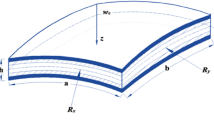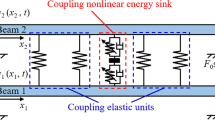Abstract
Various researches and studies have demonstrated that spider silk is much stronger and more deformable than a steel string of the same diameter from a mechanical approach. These excellent properties have caused many scientific disciplines to get involved, such as bio-mechanics, bio-materials and bio-mimetics, in order to create a material of similar properties and characteristics. It should be noted that the researches and studies have been oriented mainly as a quasi-static model. For this research, the analysis has taken a dynamic approach and determined the dissipation energy of a structure which is made of spider silk “Dragline” and produced by the Argiope-Argentata spider, through an analytical-experimental way, when being subjected to impulsive loading. Both experimental and analytical results, the latter obtained by using adjusted models, have given high levels of dissipation energy during the first cycle of vibration, which are consistent with the values suggested by other authors.
Similar content being viewed by others
References
Gosline J M, Guerette P A, Ortlepp C S, et al. The mechanical design of spider silks: From fibroin sequence to mechanical function. The Journal of experimental biology, 1999, 202(Pt 23): 3295–3303
Friedrichr B. Vibration and spider behavior. In: Haupt J, ed. XI Europäisches Arachnologisches Colloquium. Berline, 1988 (in German)
Agnarsson I, Kuntner M, Blackledge T A. Bioprospecting finds the toughest biological material: Extraordinary silk from a giant riverine orb spider. Toughest Biomaterial, 2010, 5(9): e11234
AnitaH.TheWonderfulWorldofarachnids.MexicoCityFondodeCulturaEconómica1993(in Spanish
Vollrath F. Strength and structure of spiders’ silks. Review in Molecular Biotechnology, 2000, 74(2): 67–83
Ko F K, Jovicic J. Modeling of mechanical properties and structural design of spider web. Biomacromolecules, 2004, 5(3): 780–785
Lin L H, Edmonds D T, Vollrath F. Structural engineering of an orbspider’s web. Nature, 1995, 373(6510): 146–148
Alencastre J, Vera Mechan J. Caracterización de los parámetros dinámicos de una estructura hecha de seda de araña. In: 11° Congreso Interamericano de Computación. 2013 (in Spanish)
Pérez Rigueiro J M, Elicesy G V. Strategies of Nature in the Design of Materials: Spider Silk. Online Library of Iberian Arachnology Group, 2002 (in Spanish)
Sensenig A T, Lorentz K A, Kelly S P, et al. Spider orb webs rely on radial threads to absorb prey kinetic energy. Journal of the Royal Society, Interface, 2012, 9(73): 1880–1891
Blamires S J, Wu C L, Blackledge T A, et al. Post-secretion processing influences spider silk performance. Journal of the Royal Society, Interface, 2012, 9(75): 2479–2487
Author information
Authors and Affiliations
Corresponding author
Rights and permissions
About this article
Cite this article
Alencastre, J., Mago, C. & Rivera, R. Determination of energy dissipation of a spider silk structure under impulsive loading. Front. Mech. Eng. 10, 306–310 (2015). https://doi.org/10.1007/s11465-015-0349-7
Received:
Accepted:
Published:
Issue Date:
DOI: https://doi.org/10.1007/s11465-015-0349-7




